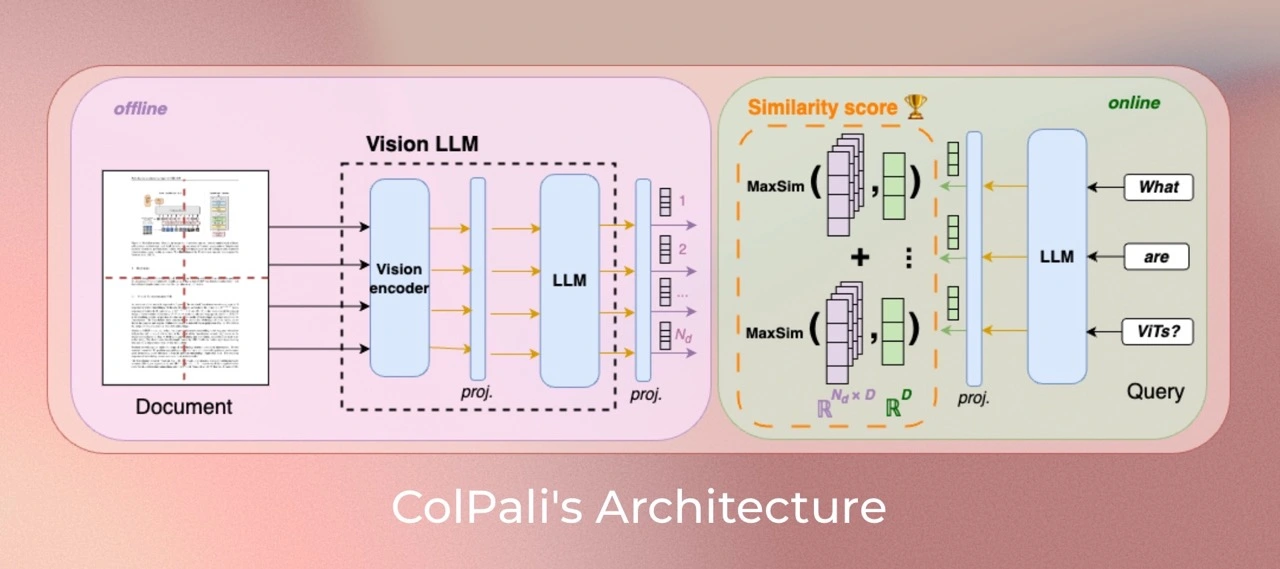ColPali: Visual Retriever based on PaliGemma-3B with ColBERT strategy
ColPali is a model based on a novel model architecture and training strategy based on Vision Language Models (VLMs) to efficiently index documents from their visual features. It is a PaliGemma-3B extension that generates ColBERT- style multi-vector representations of text and images. It was introduced in the paper ColPali: Efficient Document Retrieval with Vision Language Models and first released in this repository

Version specificity
This version is trained with colpali-engine==0.2.0 but can be loaded for any version >=0.2.0.
Compared to colpali, this version is trained with right padding for queries to fix unwanted tokens in the query encoding.
It also stems from the fixed vidore/colpaligemma-3b-pt-448-base to guarantee deterministic projection layer initialization.
It was trained for 5 epochs, with in-batch negatives and hard mined negatives and a warmup of 1000 steps (10x longer) to help reduce non-english language collapse.
Data is the same as the ColPali data described in the paper.
Model Description
This model is built iteratively starting from an off-the-shelf SigLIP model. We finetuned it to create BiSigLIP and fed the patch-embeddings output by SigLIP to an LLM, PaliGemma-3B to create BiPali.
One benefit of inputting image patch embeddings through a language model is that they are natively mapped to a latent space similar to textual input (query). This enables leveraging the ColBERT strategy to compute interactions between text tokens and image patches, which enables a step-change improvement in performance compared to BiPali.
Model Training
Dataset
Our training dataset of 127,460 query-page pairs is comprised of train sets of openly available academic datasets (63%) and a synthetic dataset made up of pages from web-crawled PDF documents and augmented with VLM-generated (Claude-3 Sonnet) pseudo-questions (37%). Our training set is fully English by design, enabling us to study zero-shot generalization to non-English languages. We explicitly verify no multi-page PDF document is used both ViDoRe and in the train set to prevent evaluation contamination. A validation set is created with 2% of the samples to tune hyperparameters.
Note: Multilingual data is present in the pretraining corpus of the language model (Gemma-2B) and potentially occurs during PaliGemma-3B's multimodal training.
Parameters
All models are trained for 1 epoch on the train set. Unless specified otherwise, we train models in bfloat16 format, use low-rank adapters (LoRA)
with alpha=32 and r=32 on the transformer layers from the language model,
as well as the final randomly initialized projection layer, and use a paged_adamw_8bit optimizer.
We train on an 8 GPU setup with data parallelism, a learning rate of 5e-5 with linear decay with 2.5% warmup steps, and a batch size of 32.
Usage
Install colpali-engine:
pip install colpali-engine>=0.3.0,<0.4.0
Then run the following code:
from typing import cast
import torch
from PIL import Image
from colpali_engine.models import ColPali, ColPaliProcessor
model = cast(
ColPali,
ColPali.from_pretrained(
"vidore/colpali-v1.2",
torch_dtype=torch.bfloat16,
device_map="cuda:0", # or "mps" if on Apple Silicon
),
)
processor = cast(ColPaliProcessor, ColPaliProcessor.from_pretrained("vidore/colpali-v1.2"))
# Your inputs
images = [
Image.new("RGB", (32, 32), color="white"),
Image.new("RGB", (16, 16), color="black"),
]
queries = [
"Is attention really all you need?",
"Are Benjamin, Antoine, Merve, and Jo best friends?",
]
# Process the inputs
batch_images = processor.process_images(images).to(model.device)
batch_queries = processor.process_queries(queries).to(model.device)
# Forward pass
with torch.no_grad():
image_embeddings = model(**batch_images)
querry_embeddings = model(**batch_queries)
scores = processor.score_multi_vector(querry_embeddings, image_embeddings)
Limitations
- Focus: The model primarily focuses on PDF-type documents and high-ressources languages, potentially limiting its generalization to other document types or less represented languages.
- Support: The model relies on multi-vector retreiving derived from the ColBERT late interaction mechanism, which may require engineering efforts to adapt to widely used vector retrieval frameworks that lack native multi-vector support.
License
ColPali's vision language backbone model (PaliGemma) is under gemma license as specified in its model card. The adapters attached to the model are under MIT license.
Contact
- Manuel Faysse: manuel.faysse@illuin.tech
- Hugues Sibille: hugues.sibille@illuin.tech
- Tony Wu: tony.wu@illuin.tech
Citation
If you use any datasets or models from this organization in your research, please cite the original dataset as follows:
@misc{faysse2024colpaliefficientdocumentretrieval,
title={ColPali: Efficient Document Retrieval with Vision Language Models},
author={Manuel Faysse and Hugues Sibille and Tony Wu and Bilel Omrani and Gautier Viaud and Céline Hudelot and Pierre Colombo},
year={2024},
eprint={2407.01449},
archivePrefix={arXiv},
primaryClass={cs.IR},
url={https://arxiv.org/abs/2407.01449},
}
- Downloads last month
- 6
Model tree for impactframes/colpali-v1.2
Base model
google/paligemma-3b-pt-448